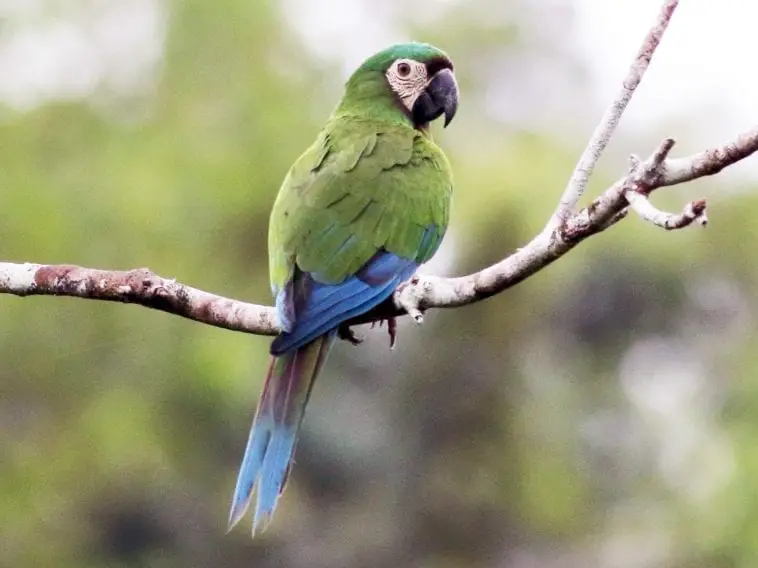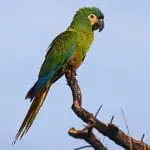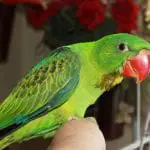Scientific Facts
| Common Name: | Chestnut-fronted Macaw, Brazilian green macaw, Severe macaw |
| Scientific Name: | Ara severus |
| Life Span: | Up to 30 years |
| Weight: | 10.7 to 13.5 ounces |
| Length: | 15 to 20 inches |
| Habitat: | Farmlands and forests |
| Country of Origin: | Brazil, Panama, Bolivia |
Physical Description
The Chestnut-fronted macaws mostly have a shimmery dark green with dark patches on their foreheads and under their beaks. The crown of their head also boasts a patch of iridescent blue feathers, and they also bear distinguishable red patches towards the edges of their wings. Additionally, they have blue tail feathers, which shimmer while they are flying. Like other macaws, these birds also have fine, dark feather lines circling their eyes.
These macaws can also be characterized by their grey beak and feet. They also have beautiful yellow-gold color in the iris of their eyes. These birds are also monomorphic, which means that the males and the females are identical in their physical appearance. Their genders cannot be identified just through visual observation. The only reliable way of determining the sex of a Chestnut-fronted macaw is through DNA testing or examination with an endoscope. The males do tend to be larger, have a larger skull, and they are also more aggressive in the overall personality.
Conservation Status
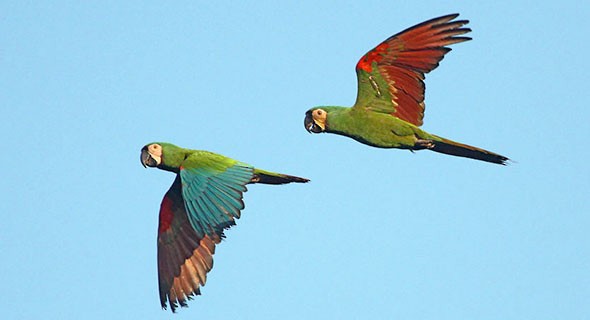
The Chestnut-fronted macaws are quite common throughout its natural range. These birds were able to survive deforestation and even capitalize on open woodlands and savannahs. This is why both locals and tourists enjoy these birds as beautiful creatures of nature. Thankfully, these Chestnut-fronted macaws are not endangered and are of least concern, but this can quickly change if deforestation and habitat destruction do not stop.
Availability and Natural Habitat
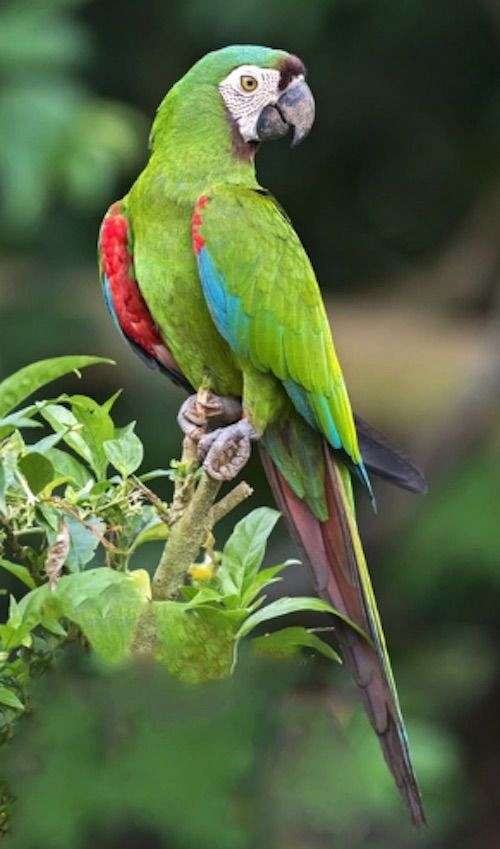
The Chestnut-fronted macaw is native to areas in the north of South America and the south of Central America. Particularly, these birds can be found living in Bolivia and Panama. Additionally, some populations of the chestnut-fronted macaw can be found in Brazil, which is why they can sometimes be called the Brazilian green macaw. Some places also report that there are Chestnut-fronted macaws seen in Florida as well.
In the wild, the Chestnut-fronted macaws are seen to populate in forests and habitats where there are lots of trees available. These birds prefer areas that are prone to river flooding. Spotting these birds can be a little difficult because they love to roost in cavities high up in the trees.
The Chestnut-fronted macaws love looking for food in farm fields, and usually, these places are enough to sustain their natural diets. They also enjoy staying in the clay hills.
Behavior, Exercise, and Training
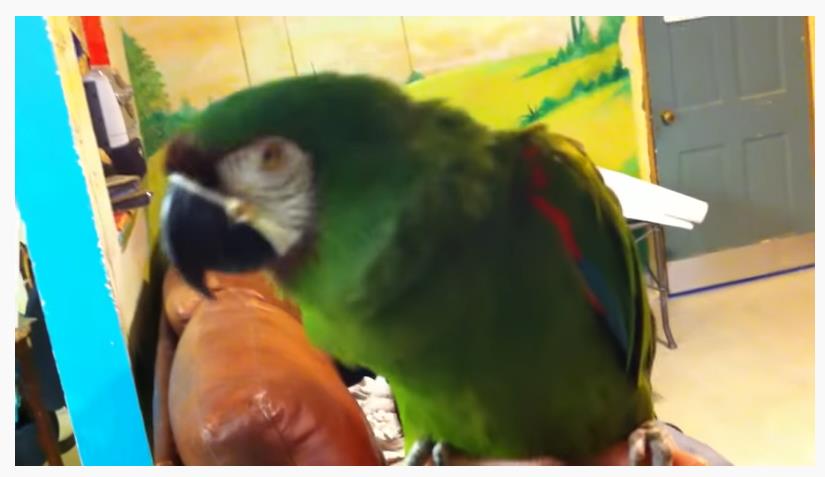
Video Source
Embed Code: <iframe width=”640″ height=”360″ src=”https://www.youtube.com/embed/DEpw2cwjUVI” frameborder=”0″ allow=”accelerometer; autoplay; encrypted-media; gyroscope; picture-in-picture” allowfullscreen></iframe>
Unlike other species of birds, chestnut-fronted macaws have not been bred in captivity that long. This means that many of their natural instincts are still intact because full domestication has not been finalized yet. But, if they are acquired as young birds, they make good pets.
The Chestnut-fronted macaw has a large personality that is a combination of comical and friendly. With adequate socialization, these macaws form quick bonds with their owners, and they respond to training, and they still boast their impressive speech abilities.
These birds are also known to love talking, but birds have different personalities that can be hard to identify. Many of them can speak with loads of clarity, and their voices are high-pitched that people can listen to. If trained, the Chestnut-fronted macaws can develop a large vocabulary.
For chestnut-fronted macaws, their vocalizations can be quite great, and this stress can be so much for most owners and their neighbors. Considering their size, they can be very loud birds and are known to call out in the morning, at noon, and before the sunsets. As pets, it would be better to ignore their screams, rather than to scold them, and lead them to become much worse.
Food and Eating Habits
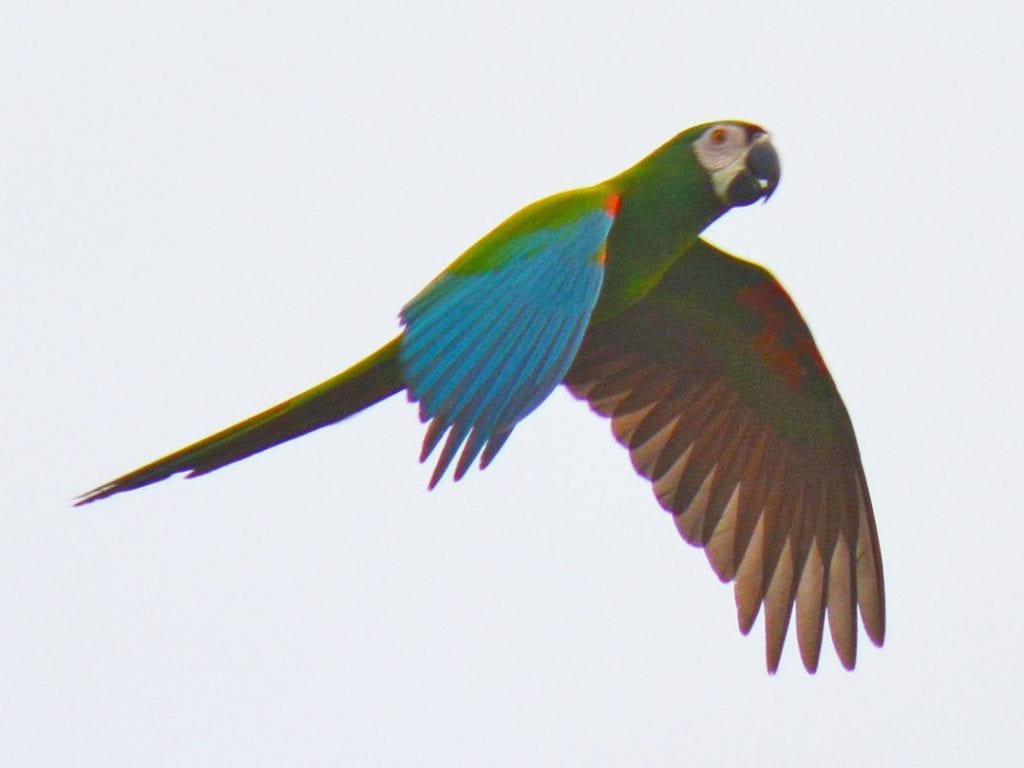
Video Source
Embed: <iframe width=”640″ height=”360″ src=”https://www.youtube.com/embed/H6uYacD7t40″ frameborder=”0″ allow=”accelerometer; autoplay; encrypted-media; gyroscope; picture-in-picture” allowfullscreen></iframe>
Like any other bird that you can use as a pet, the Chestnut-fronted macaws must have adequate nutrition to thrive. Feed the birds a diet with a variety of pellet mix and high-quality seeds. Birds like this macaw will enjoy eating fresh fruits and vegetables to supplement the vitamins and minerals that they need, just to ensure that you can meet your dietary requirements.
Breeding
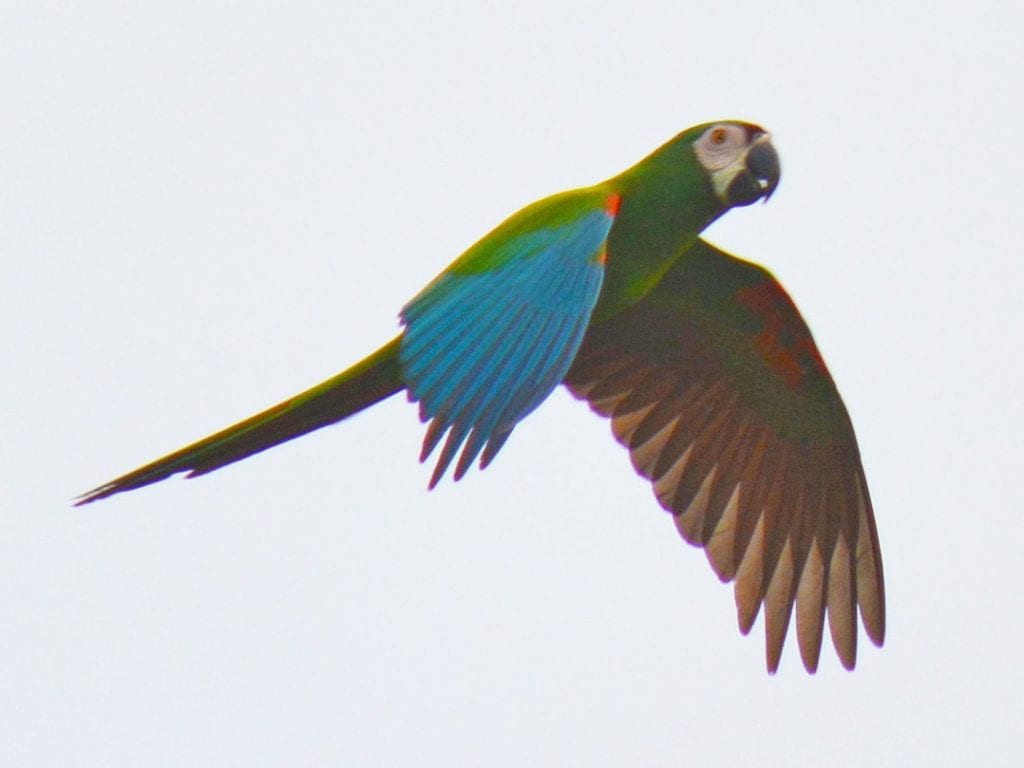
The breeding season for the Chestnut-fronted macaws differs depending on their locations. When they are in Panama, they usually breed from February to March. In Colombia, they breed from March to May, while they breed from September to December in the Guianas and Suriname.
Usually, these Chestnut-fronted macaws nest in the cavities of living trees, even those who are dead.
For these chestnut-fronted macaws, their average clutch consists of 2 to 3 oval white eggs that usually measure about 1.2 by 1.5 inches in size. These eggs are incubated for about 26 to 28 inches before they hatch. The young fledglings leave the nest when they are about 3 months old, but they will remain living with their parents for some time afterward.
Handling
In general, most Chestnut-fronted macaws do not like excessive touching, but each bird is different, and their individual personalities can vary. Gauge your bird’s behavior before deciding what works best. These Chestnut-fronted macaws do enjoy being petted alongside the back of their necks, along with their beaks, or around their eyes. These birds are perfectly content sitting on their owner’s shoulders while a person does chores or even being placed on a bird stand with the owner nearby.
Additionally, any shiny objects and jewelry will quickly amaze the Chestnut-fronted macaws. For this reason, all earrings, bracelets, chains, and watches must be put away before handling as they might break if the Chestnut-fronted macaws decide to play with them.
Common Health Problems
The Chestnut-fronted macaws are adaptable birds, and they are known to be quite hardy. They will not have any trouble, and they are considered as robust and healthy birds. This can be maintained by a lot of attention, which includes diet, hygiene, and social interaction. The Chestnut-fronted macaws create strong bonds, and they depend on the friendship and company of humans.
In assuring health for these birds, cleanliness of their cage and your Chestnut-fronted macaw itself must always be observed. Bather them regularly with sprinkling water and allow them to dry well. Make your Chestnut-fronted macaw socialize with as many new people as possible to curb its tendency of becoming a one-person bird. Always keep the Chestnut-fronted macaws under your close supervision while they are out of their cage to make sure that they will not be exposed to toxic elements lying around their environment.
Some of the most common health conditions are:
- Beak malformations
- Pancreatitis
- Viral infections
- Fungal infections
- Bacterial infections
- Constricted toe syndrome
- Kidney disease
- Proventricular Dilatation Disease
- Feather picking
- Psittacosis
Environment and Housing
There are numerous cages that are available in the market today that owners are free to choose from the various styles and designs. The most important thing to consider when choosing an enclosure is that it should be spacious enough for the Chestnut-fronted macaws. An adequate cage will allow the chestnut-fronted macaw to move without any part of their body, touching the cage bars. When these macaws flap their wings, they should not touch the walls of the cage.
Though these macaws might seem small compared to their larger macaw relatives, they are still very active, and they require a spacious room for them to feel happy and healthy. In the wild, these birds enjoy the luxury of playing, foraging, and flying about. But, chestnut-fronted macaws in captivity do not have the same freedom, so it’s important to purchase a large one as big as your budget can afford.
The cage should either be made of stainless steel or powder-coated. Owners should never use galvanized cages or bars that have zinc because these chemicals can be toxic for the bird. The bars should also not be spaced more than one inch apart to ensure that the parrot’s head does not become stuck.
All the food and water bowls should have their own doors for easier access. The bottom of these cages must have a grill to keep the parrot away from its own droppings where moldy food and harmful bacteria can reside. These grills can just be slid out for cleaning, washing, and disinfecting.
Fun Facts about the Chestnut-fronted Macaw
The Chestnut-fronted macaws are mainly colored green, and they have red and blue patches on their wings.
- The main predators of Chestnut-fronted macaws are boa constrictors and humans. They are also known to live up to 40 years.
- The Chestnut-fronted macaws got their nickname of severe macaw because of their aggressive behavior.
- Out of all the mini-macaws, the Chestnut-fronted macaws are the largest.
- The ornithologist that discovered the chestnut-fronted macaw named them after the aspects of their plumage that are colored by chestnut.
- The male and female Chestnut-fronted macaws are almost identical, and the juveniles are hardly different from the adults.
- Sometimes, the Chestnut-fronted macaws can be seen eating in the company of the Ara manilata when they are in the wild.
- In the wild, these Chestnut-fronted macaws also live in pairs or in small groups.
- These Chestnut-fronted macaws usually nest in the cavities of dead palm trees, often just above the water, but sometimes, they lay eggs in a rocky crevice.
- The Chestnut-fronted macaws are often confused with two other bird species: blue-winged macaw and the red-bellied macaw.
Where Can You Get a Pet Chestnut-fronted Macaw?
Several years ago, chestnut-fronted macaws joined the various species of birds that are kept in captivity. At one time, most of the breeding stock was acquired through the importation of wild specimens. This has changed since then, and most Chestnut-fronted macaws that are sold today came from generations of captive-bred birds. This means these parrots are not domestic, originally, so owners can expect some natural behaviors.
Mostly, these Chestnut-fronted macaws are not difficult to find if you want to acquire one. They can be purchased from bird shows, pet shops, and local breeders. These Chestnut-fronted macaws are popular because of their friendly disposition, and most likely, chestnut-fronted macaws will continue in popularity in the future.
How to Care for a Pet Chestnut-fronted Macaw?
Embed: <iframe width=”640″ height=”360″ src=”https://www.youtube.com/embed/PB7tP3NPwW0″ frameborder=”0″ allow=”accelerometer; autoplay; encrypted-media; gyroscope; picture-in-picture” allowfullscreen></iframe>
While Chestnut-fronted macaws are famous for being very social, they still require a certain amount of training to ensure that the bird remains peaceful and tame. If you want to adopt one for yourself, the first thing that you should do is to make sure that you have enough time to spend with the chestnut-fronted macaw each day.
Without adequate mental stimulation as well as socialization, the Chestnut-fronted macaws can become stressed, bored, and depressed. This can lead to destructive behavior and related illnesses.
The Chestnut-fronted macaws are fun pets, but they require specialized care and some time that not all people can provide. They actually thrive on their time spent with their human family because this replicates the feeling of living with a flock. So, unlike other birds, they are not loyal to one person only.
So, before you bring any Chestnut-fronted macaw into your home to take care of them, make sure that you are well-prepared. You should also think about the costs of high-quality feed, veterinary bills, and the prices of toys and cages.
For such a small bird, you will be able to find a larger cage that will do them quite well. These macaws need lots of room and are used to long flights while in the wild, so it is best to go bigger for their enclosures.
Frequently Asked Questions
How much does a Chestnut-fronted macaw cost?
Chestnut-fronted macaws are available for around 700 dollars up to 2,000 dollars.
Do Chestnut-fronted macaws make good pets?
The Chestnut-fronted macaws have not always been bred in captivity for as long as other parrots. They are ideal pets when they have been raised in captivity even while they are still young.
How long do Chestnut-fronted macaws live?
Red-shoulder macaws live for about 40 years, on average.
Are Chestnut-fronted macaws loud?
Chestnut-fronted macaws can become loud, and their calls and caws are a part of their nature.
What do Chestnut-fronted macaws eat?
Chestnut-fronted macaws eat a variety of eating commercial pellets, fruits, nuts, seeds, as well as fresh fruits and vegetables.

